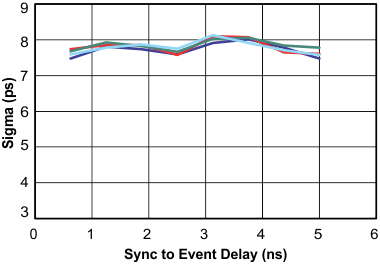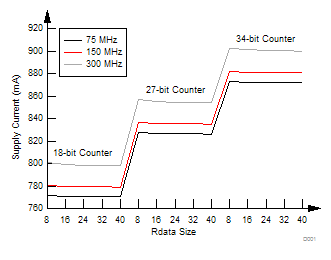SLOS616D March 2010 – March 2015 THS788
PRODUCTION DATA.
- 1 Features
- 2 Applications
- 3 Description
- 4 Simplified Schematic
- 5 Revision History
- 6 Pin Configuration and Functions
- 7 Specifications
- 8 Detailed Description
- 9 Application and Implementation
- 10Power Supply Recommendations
- 11Layout
- 12Device and Documentation Support
- 13Mechanical, Packaging, and Orderable Information
Package Options
Mechanical Data (Package|Pins)
- PFD|100
Thermal pad, mechanical data (Package|Pins)
- PFD|100
Orderable Information
7 Specifications
7.1 Absolute Maximum Ratings
over operating junction temperature range (unless otherwise noted)| MIN | MAX | UNIT | |||
|---|---|---|---|---|---|
| VCC | 4 | V | |||
| Analog I/O to GND(2) | –0.3 | VCC + 0.3 | V | ||
| Digital I/O to GND | –0.3 | VCC + 0.3 | V | ||
| TJ | Maximum junction temperature(1) | 150 | °C | ||
| Tstg | Storage temperature | 150 | °C | ||
(1) The THS788 device has an automatic power shutdown at 140°C, typical.
(2) LVDS outputs are not short-circuit-proof to GND.
7.2 ESD Ratings
| VALUE | UNIT | ||||
|---|---|---|---|---|---|
| V(ESD) | Electrostatic discharge | Human body model (HBM), per ANSI/ESDA/JEDEC JS-001, all pins(1) | ±2000 | V | |
| Charged device model (CDM), per JEDEC specification JESD22-C101, all pins(2) | ±250 | ||||
(1) JEDEC document JEP155 states that 500-V HBM allows safe manufacturing with a standard ESD control process.
(2) JEDEC document JEP157 states that 250-V CDM allows safe manufacturing with a standard ESD control process.
7.3 Recommended Operating Conditions
over operating junction temperature range (unless otherwise noted)| MIN | NOM | MAX | UNIT | ||
|---|---|---|---|---|---|
| VCC | Supply voltage | 3.135 | 3.465 | V | |
| TJ | Junction temperature | 0 | 105 | °C | |
| MCLOCK frequency | 200 | MHz | |||
7.4 Thermal Information
| THERMAL METRIC(1) | THS788 | UNIT | |
|---|---|---|---|
| PFD (HTQFP) | |||
| 100 PINS | |||
| RθJA | Junction-to-ambient thermal resistance | 27.2 (60.2 without heat sink) |
°C/W |
| RθJC(top) | Junction-to-case (top) thermal resistance | 0.6 | |
| RθJB | Junction-to-board thermal resistance | 6.8 | |
| ψJT | Junction-to-top characterization parameter | 0.6 | |
| ψJB | Junction-to-board characterization parameter | 6.8 | |
| RθJC(bot) | Junction-to-case (bottom) thermal resistance | N/A | |
(1) For more information about traditional and new thermal metrics, see the IC Package Thermal Metrics application report, SPRA953.
7.5 Electrical Characteristics
Typical conditions are at TJ = 55°C and VCC = 3.3 V.7.6 Host Serial Interface DC Characteristics
over operating junction temperature range (unless otherwise noted)| PARAMETER | TEST CONDITIONS | MIN | TYP | MAX | UNIT | |
|---|---|---|---|---|---|---|
| VIH | High-level input voltage | 0.7 × VCC | VCC + 0.5 | V | ||
| VIL | Low-level input voltage | GND – 0.3 | 0.3 × VCC | V | ||
| VOH | High-level output voltage | VCC – 0.5 | VCC + 0.3 | V | ||
| VOL | Low-level output voltage | 0 | 0.4 | V | ||
| Ilkg | Leakage current | 1 | µA | |||
7.7 Host Serial Interface AC Characteristics
over operating junction temperature range (unless otherwise noted)| PARAMETER | TEST CONDITIONS | MIN | TYP | MAX | UNIT | |
|---|---|---|---|---|---|---|
| HCLK frequency | 50 | MHz | ||||
| Rise and fall times | 3.5 | ns | ||||
| HCLK duty cycle | 40% | 50% | 60% | |||
| Hstrobe high period between two consecutive transactions | 40 | ns | ||||
| Hstrobe low to HCLK high setup | 5 | ns | ||||
| HCLK high to Hstrobe high hold time | 5 | ns | ||||
| Hdata in to HCLK high setup | 5 | ns | ||||
| Hdata in to HCLK high hold time | 5 | ns | ||||
| HCLK falling edge to Hdata out (L or H) | CL = 20 pF | 3.25 | ns | |||
| HCLK falling edge to Hdata out (H or L) | CL = 20 pF | 3.25 | ns | |||
7.8 Power Consumption
Typical conditions are at 55°C junction temperature, VCC = 3.3 V| CONDITION | CURRENT | UNIT | ||||
|---|---|---|---|---|---|---|
| TYP | MAX | |||||
| One channel plus sync, counter length = 18 bits, output interface speed = 75 MHz | 420 | mA | ||||
| As above with an additional channel | add 125 | mA | ||||
| Output interface speed | 150 MHz | add 10 | mA | |||
| 300 MHz | add 25 | |||||
| Counter length | 27 bits | add 60 | mA | |||
| 34 bits | add 105 | |||||
| Four-channel current | 18 bits | 75 MHz | 795 | 1075 | mA | |
| 150 MHz | 805 | 1090 | ||||
| 300 MHz | 820 | 1101 | ||||
| 27 bits | 75 MHz | 855 | 1150 | |||
| 150 MHz | 865 | 1165 | ||||
| 300 MHz | 880 | 1176 | ||||
| 34 bits | 75 MHz | 900 | 1210 | |||
| 150 MHz | 910 | 1225 | ||||
| 300 MHz | 925 | 1236 | ||||
7.9 Typical Characteristics

